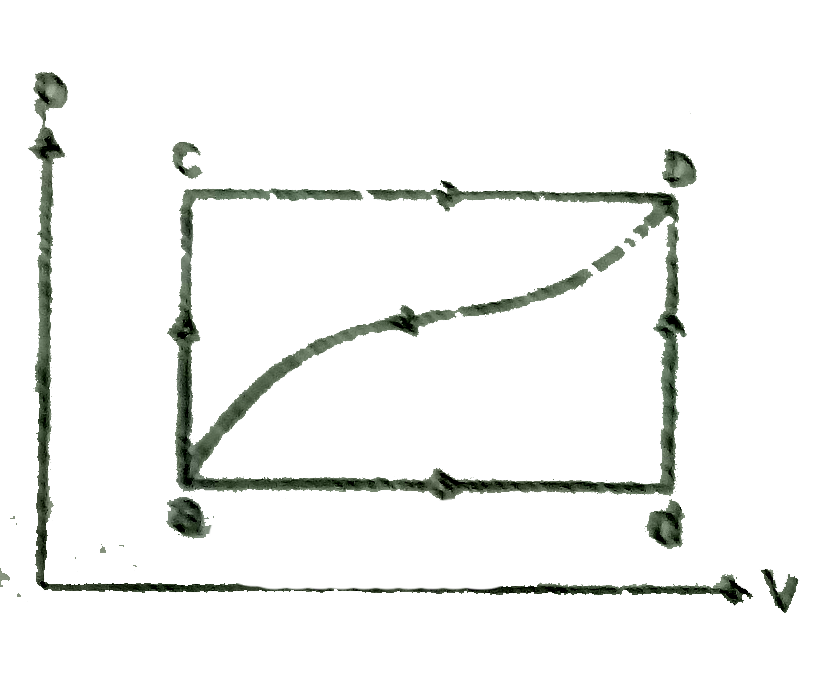When a thermodynamic system is taken from an initial state I to a final state F along the path IAF, as shown in Fig. the heat energy absorbed by the system is Q=55J and work done by the system is W=25J. If the same system is taken along the path IBF, the value of Q=35J.
(a) If W=−15J for the curved path FI, how much heat energy is lost by the system along this path ?
(b) If U1=10J, what is UF ?
(d) If UB=20J, what is Q for the process BF and IB ?
To solve the given problem step by step, we will break it down into parts (a), (b), and (c) as per the question.
Given Data:
1. For path IAF:
- Heat absorbed, QIAF=55J
- Work done, WIAF=25J
2. For path IBF:
- Heat absorbed, QIBF=35J
- Work done, WIBF=?
3. For path FI:
- Work done, WFI=−15J
4. Change in internal energy for path IAF:
- U1=10J
- UB=20J
Part (a): Heat Energy Lost Along Path FI
Using the first law of thermodynamics:
Q=W+ΔU
For path IAF:
QIAF=WIAF+(UF−UI)
Substituting the known values:
55=25+(UF−U1)
ΔU=UF−U1=55−25=30J(Equation 1)
Now for path FI:
QFI=WFI+ΔU
Substituting the known values:
QFI=−15+(UF−UI)
From Equation 1, we know UF−UI=30J:
QFI=−15+30=15J
Part (b): Finding UF
From Equation 1:
UF−U1=30J
Substituting U1=10J:
UF−10=30
UF=40J
Part (c): Finding Q for Processes BF and IB
For process BF:
- Since the volume is constant, WBF=0.
- Thus, QBF=ΔUBF.
The change in internal energy from B to F:
ΔUBF=UF−UB=40−20=20J
So, QBF=20J.
Now for process IB:
Using the first law:
QIB=WIB+ΔUIB
We need to find WIB. From the path IBF:
QIBF=WIBF+ΔUIBF
We know QIBF=35J and ΔUIBF=30J:
35=WIBF+30
WIBF=5J
Now, using the first law for IB:
QIB=WIB+ΔUIB
Where ΔUIB=UB−UI=20−10=10J:
QIB=WIB+10
We know WIB=−5J (since it is the opposite of WIBF):
QIB=−5+10=5J
Summary of Results:
- Heat energy lost along path FI: QFI=15J
- Internal energy at F: UF=40J
- Heat for process BF: QBF=20J
- Heat for process IB: QIB=5J
1. For path IAF:
- Heat absorbed, QIAF=55J
- Work done, WIAF=25J
- Heat absorbed, QIBF=35J
- Work done, WIBF=?
- Work done, WFI=−15J
- U1=10J
- UB=20J
Using the first law of thermodynamics:
Q=W+ΔU
For path IAF:
QIAF=WIAF+(UF−UI)
Substituting the known values:
55=25+(UF−U1)
ΔU=UF−U1=55−25=30J(Equation 1)
QFI=WFI+ΔU
Substituting the known values:
QFI=−15+(UF−UI)
From Equation 1, we know UF−UI=30J:
QFI=−15+30=15J
From Equation 1:
UF−U1=30J
Substituting U1=10J:
UF−10=30
UF=40J
For process BF:
- Since the volume is constant, WBF=0.
- Thus, QBF=ΔUBF.
ΔUBF=UF−UB=40−20=20J
So, QBF=20J.
Using the first law:
QIB=WIB+ΔUIB
We need to find WIB. From the path IBF:
QIBF=WIBF+ΔUIBF
We know QIBF=35J and ΔUIBF=30J:
35=WIBF+30
WIBF=5J
QIB=WIB+ΔUIB
Where ΔUIB=UB−UI=20−10=10J:
QIB=WIB+10
We know WIB=−5J (since it is the opposite of WIBF):
QIB=−5+10=5J
- Heat energy lost along path FI: QFI=15J
- Internal energy at F: UF=40J
- Heat for process BF: QBF=20J
- Heat for process IB: QIB=5J
Topper's Solved these Questions
- KINETIC THEORY OF GASES AND FIRST LAW OF THERMODYNAMICSBOOK - CENGAGE PHYSICS ENGLISHCHAPTER - KINETIC THEORY OF GASES AND FIRST LAW OF THERMODYNAMICSEXERCISE - Solved Examples
14 Videos
- KINETIC THEORY OF GASES AND FIRST LAW OF THERMODYNAMICSBOOK - CENGAGE PHYSICS ENGLISHCHAPTER - KINETIC THEORY OF GASES AND FIRST LAW OF THERMODYNAMICSEXERCISE - Exercise 2.1
20 Videos
- KINETIC THEORY OF GASESBOOK - CENGAGE PHYSICS ENGLISHCHAPTER - KINETIC THEORY OF GASESEXERCISE - Compression
2 Videos
- LINEAR AND ANGULAR SIMPLE HARMONIC MOTIONBOOK - CENGAGE PHYSICS ENGLISHCHAPTER - LINEAR AND ANGULAR SIMPLE HARMONIC MOTIONEXERCISE - Single correct anwer type
14 Videos
Similar Questions
For a gaseous state if heat supplied to the system is 100 J and work done by the system is 25 J. then internal energy of the system is
View SolutionFind the change in internal energy if heat supplied to the gaseous system is 100 J and work done by the system is 80 J.
View Solutiona thermodynamic system is taken from the state i to statef along the path iaf. It is found that the heat absorbed by the system is 40 cal and work done by the system is 16.19 cal. Along the path i bf, the heat absorbed is 35 cal.
(a) Find the work done along the path i bf.
(b) If W = - 10 cal for the curved return path fi, what is for this path ?
(c) Take Ub=20cal, what is Uf?
(d) If Ub=20 cal, what is for the process ib?

View SolutionFor a gaseous system, if heat rejected by the system is 100J and work done by the system is 20J , then change in internal energy is
View SolutionFor a gaseous system find change in internal energy if the heat supplied to the system is 50 J and work done by the system is 16 J.
View SolutionFor a gaseous system find change in internal energy if the heat supplied to the system is 50 J and work done by the system is 16 J.
View SolutionA system is provided 50J of heat and work done on the system is 20J. What is the change in the internal enegry?
View SolutionA system is provided 50J of heat and work done on the system is 20J. What is the change in the internal enegry?
View SolutionWhen a system is taken from state 'a' to state 'b' along the path 'acd', is is found that a quantity of heat Q=200J is absorbed by the system and a work W=80J is done by it. Along the path 'adb', Q=144J. The work done along the path 'adb' is

View SolutionWhen a system is taken from state 'a' to state 'b' along the path 'acd', is is found that a quantity of heat Q=200J is absorbed by the system and a work W=80J is done by it. Along the path 'adb', Q=144J. The work done along the path 'adb' is

View Solution
